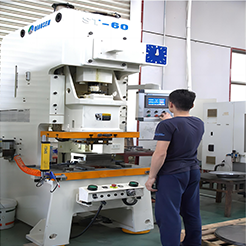
The Precision Art of Spin Forming: Unveiling the Technique
Spin forming stands tall as a time-honored precision metalworking technique, delving into the intricacies of shaping metallic materials. At its core lies a meticulous process intertwining engineering finesse and craftsmanship, offering an array of applications across industries. This comprehensive guide navigates through the depths of spinning forming, illuminating its essence, applications, processes, and the synergy of science and skill.
If you want to find a cost-effective and fast CNC metal forming solution, ALTRON may be a good choice for you. Based on extensive experience and expertise, our CNC metal spinning services are available for prototype manufacturing and low to high volume production. Working with ALTRON, Joby engineers’ expertise and use of advanced machinery allow us to efficiently manufacture end-use metal spun parts and products while maintaining premium quality.

Understanding Spin Forming
Spin forming is a specialized metalworking process primarily used to fabricate cylindrical or conical components by manipulating metal sheets or tubes. The technique involves the controlled rotation of a workpiece while shaping it against a mandrel or form tool. Through this controlled spinning motion and targeted pressure, the metal undergoes plastic deformation, conforming to the desired shape with unparalleled precision.
Applications Across Diverse Industries
The versatility of spinning forming transcends industries, finding its niche in aerospace, automotive, architectural, and manufacturing sectors. In aerospace, it crafts intricate engine components and satellite parts with the utmost accuracy. Within the automotive realm, it molds exhaust systems and specialized wheel rims, showcasing its adaptability. In architecture, spinning forming contributes to creating unique structures, such as artistic sculptures and ornamental features.
The Anatomy of the Process
1.Materials and Tooling
Metal Spinning Forming accommodates a variety of metals, including aluminum, stainless steel, copper, and alloys. The selection depends on the specific mechanical properties and end-use requirements. Tooling comprises mandrels, rollers, and form blocks intricately designed to shape the metal efficiently.
2.The Spin Forming Sequence
The process begins with a carefully selected metal sheet or tube clamped onto a spinning lathe or machine. As the workpiece rotates at calculated speeds, the form tool gradually applies pressure, coaxing the metal to conform to the desired shape. This continuous manipulation ensures a seamless transformation, avoiding material defects.
3.Precision and Accuracy
Precision reigns supreme in spinning forming. Minute adjustments in spinning speed, pressure application, and tool positioning determine the final product’s accuracy. Skilled operators orchestrate these variables to achieve the exact dimensions and specifications, adhering to stringent tolerances.

The Marriage of Science and Skill
Spin forming amalgamates scientific principles with the dexterity of skilled artisans. Understanding material behavior under pressure, strain, and temperature guides the process. Factors like work-hardening, springback, and metal flow dynamics play pivotal roles, demanding astute observation and adaptability from operators. Mastery of these nuances elevates spinning-forming from a mechanical process to an art form.
Challenges and Innovations
1.Material Limitations
Certain materials pose challenges due to their unique properties, such as high spring-back tendencies or sensitivity to temperature changes. Innovations in tooling designs and material treatments aim to overcome these limitations, expanding the spectrum of metals viable for spinning forming.
2.Complex Geometries
Intricate shapes and complex geometries present hurdles in maintaining uniform thickness and structural integrity. Advanced computer-aided design (CAD) software coupled with simulation tools assists in predicting and mitigating these challenges, ensuring precision in the final product.
The Future of Spinning Forming
The horizon of spinning-forming gleams with potential advancements. Integration of artificial intelligence and machine learning could optimize process parameters, enhancing efficiency and precision further. Moreover, advancements in materials science may unlock new frontiers, allowing spinning forming to explore uncharted territories of material applications.
In Conclusion
Spinning forming remains a cornerstone of precision metalworking, entwining scientific principles with the finesse of craftsmanship. Its evolution continues to reshape industries, propelling innovation and enabling the realization of intricate designs. As technology marches forward, the artistry and precision of spin forming continue to carve a distinct niche in the world of manufacturing and engineering.






The Precision Art of Spin Forming: Unveiling the Technique

Hot Metal Spinning Process

Punching machine processing service

Centrifugal fan impeller internal welding robot

Lampshade metal polishing process

